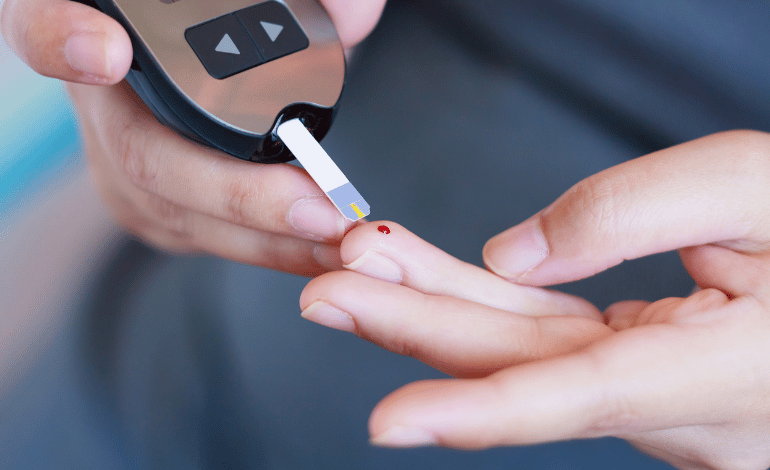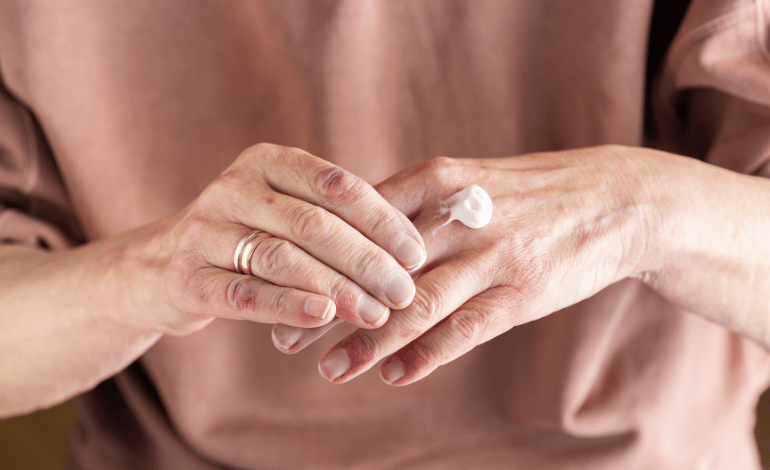Diabetes: Types, Causes, Symptoms, and Treatments

Diabetes: Types, Causes, Symptoms, and Treatments: Diabetes is a chronic metabolic disorder that affects millions of people worldwide. It is a condition in which the body is unable to properly regulate blood sugar (glucose) levels due to either insufficient insulin production or insulin resistance. As a result, people with diabetes experience elevated levels of blood sugar, which can lead to a range of health problems if left uncontrolled.
There are several types of diabetes, including type 1 diabetes, type 2 diabetes, and gestational diabetes. Type 1 diabetes, also known as juvenile diabetes, is an autoimmune disorder that occurs when the body’s immune system attacks and destroys the insulin-producing cells in the pancreas. Type 2 diabetes is a condition in which the body becomes resistant to the effects of insulin or is unable to produce enough insulin to maintain normal blood sugar levels. Gestational diabetes is a type of diabetes that develops during pregnancy and usually resolves after delivery.
Understanding the different types of diabetes is crucial for effective management and treatment of the condition. Although there is no cure for diabetes, it can be managed through lifestyle changes, medication, and regular monitoring of blood sugar levels. Proper management of diabetes is important to prevent complications such as cardiovascular disease, nerve damage, kidney damage, eye damage, and foot damage.
In the following sections, we will take a closer look at the causes, symptoms, diagnosis, treatment options, and complications associated with each type of diabetes. We will also discuss prevention and management strategies that can help individuals with diabetes lead healthy, fulfilling lives.
Causes of Diabetes
The causes of diabetes depend on the type of diabetes.
Type 1 diabetes is an autoimmune disorder in which the body’s immune system attacks and destroys the insulin-producing cells in the pancreas. The exact cause of this autoimmune response is unknown, but it is believed to be a combination of genetic and environmental factors.
Type 2 diabetes is primarily caused by insulin resistance, which means that the body becomes less responsive to the effects of insulin. Insulin resistance can be caused by a variety of factors, including obesity, physical inactivity, genetic factors, age, and ethnicity. In people with type 2 diabetes, the pancreas initially produces more insulin to compensate for the reduced effectiveness of insulin, but over time, it may not be able to keep up with the demand, leading to elevated blood sugar levels.
Gestational diabetes is caused by hormonal changes during pregnancy that can lead to insulin resistance. Women who are overweight, have a family history of diabetes, or have previously given birth to a baby weighing more than 9 pounds are at an increased risk of developing gestational diabetes.
Other less common forms of diabetes, such as monogenic diabetes and cystic fibrosis-related diabetes, are caused by genetic mutations that affect the function of insulin-producing cells or insulin action.
In general, diabetes is a complex disease with multiple underlying factors that contribute to its development. Obesity, physical inactivity, poor diet, and genetic factors all play a role in the development of diabetes. Understanding the causes of diabetes is important for effective prevention and management of the condition.
Symptoms of Diabetes
The symptoms of diabetes can vary depending on the type of diabetes and the severity of the condition.
Common symptoms of Type 1 diabetes include:
- Increased thirst and hunger
- Frequent urination
- Fatigue and weakness
- Unintentional weight loss
- Blurred vision
- Slow healing of cuts and wounds
- Tingling or numbness in the hands or feet
- Irritability or mood changes
In contrast, Type 2 diabetes may develop gradually and may not exhibit any noticeable symptoms in the early stages. However, as the condition progresses, symptoms may include:
- Increased thirst and hunger
- Frequent urination
- Fatigue and weakness
- Blurred vision
- Slow healing of cuts and wounds
- Tingling or numbness in the hands or feet
- Recurring infections, such as skin infections or urinary tract infections
Gestational diabetes may not cause any symptoms, but some women may experience increased thirst, frequent urination, and fatigue during pregnancy.
It is important to note that some people with diabetes may not experience any symptoms, especially in the early stages of the condition. Therefore, regular screening and monitoring of blood sugar levels are essential for early detection and effective management of diabetes. If you experience any of the symptoms mentioned above, it is important to consult with a healthcare professional for further evaluation and testing.
Diagnosis of Diabetes
The diagnosis of diabetes is typically made by a healthcare professional based on a combination of symptoms, medical history, and blood tests.
The most common blood test used to diagnose diabetes is the fasting plasma glucose (FPG) test. This test measures the level of glucose in the blood after an overnight fast. A blood glucose level of 126 milligrams per deciliter (mg/dL) or higher on two separate occasions typically indicates diabetes.
Another blood test commonly used to diagnose diabetes is the hemoglobin A1C (HbA1c) test. This test measures the average blood glucose level over the past 2-3 months. An HbA1c level of 6.5% or higher indicates diabetes.
In some cases, an oral glucose tolerance test (OGTT) may be used to diagnose diabetes. This test involves drinking a sugary beverage and having blood glucose levels measured over several hours. A blood glucose level of 200 mg/dL or higher 2 hours after drinking the sugary beverage indicates diabetes.
For gestational diabetes, pregnant women are typically screened between weeks 24-28 of pregnancy using the glucose challenge test. This involves drinking a sugary beverage and having blood glucose levels measured after an hour. If the blood glucose level is higher than a certain cutoff, a follow-up glucose tolerance test may be recommended.
It is important to note that the diagnosis of diabetes should be made by a healthcare professional and not based on self-diagnosis or self-testing. Early detection and proper management of diabetes are essential for preventing complications and improving long-term health outcomes.
Treatment Options for Diabetes
The treatment for diabetes typically involves a combination of lifestyle modifications, medication, and regular monitoring of blood sugar levels. The goal of treatment is to keep blood sugar levels within a target range to prevent complications associated with high or low blood sugar levels.
Lifestyle modifications may include:
- Diet: Eating a healthy, balanced diet with a focus on low-carbohydrate and low-sugar foods.
- Exercise: Engaging in regular physical activity to help lower blood sugar levels and improve overall health.
- Weight management: Maintaining a healthy weight through a combination of diet and exercise.
Medications may include:
- Insulin: Used to lower blood sugar levels for people with type 1 diabetes or for people with type 2 diabetes who cannot control their blood sugar levels through lifestyle modifications and oral medications alone.
- Oral medications: Used to lower blood sugar levels for people with type 2 diabetes. Different types of medications work in different ways, such as stimulating the pancreas to produce more insulin or reducing the amount of glucose produced by the liver.
- Other medications: May be used to manage other conditions associated with diabetes, such as high blood pressure and high cholesterol.
Regular monitoring of blood sugar levels is essential to ensure that treatment is effective and to adjust treatment as needed. People with diabetes may use a blood glucose meter to measure their blood sugar levels at home, and healthcare professionals may perform periodic tests, such as the HbA1c test, to assess long-term blood sugar control.
In addition to these treatments, it is important for people with diabetes to receive regular check-ups with their healthcare team and to participate in diabetes education programs to learn about self-care and diabetes management.
Complications Associated with Diabetes
If left uncontrolled or poorly managed, diabetes can lead to a variety of complications. Some of the common complications associated with diabetes include:
Cardiovascular Disease: Diabetes increases the risk of developing heart disease, including heart attack, stroke, and peripheral artery disease.
Nerve Damage: High blood sugar levels can cause damage to the nerves throughout the body, leading to symptoms such as numbness, tingling, and pain.
Kidney Damage: Diabetes can damage the kidneys over time, leading to kidney disease and, in severe cases, kidney failure.
Eye Damage: Diabetes can cause damage to the blood vessels in the retina, leading to a condition known as diabetic retinopathy, which can cause vision loss and blindness.
Foot Damage: High blood sugar levels can lead to poor circulation and nerve damage in the feet, making it more difficult to heal from cuts and infections and increasing the risk of amputation.
Skin Conditions: People with diabetes are at increased risk for skin infections, including bacterial and fungal infections.
Dental Disease: Diabetes can increase the risk of gum disease and other dental problems.
Depression: Diabetes is associated with an increased risk of depression and other mental health issues.
It is important for people with diabetes to work closely with their healthcare team to manage their blood sugar levels and reduce their risk of developing complications. This may involve regular check-ups, medication adjustments, and lifestyle modifications.
Conclusion
Diabetes is a chronic medical condition that affects millions of people around the world. It is caused by a disruption in the body’s ability to produce or use insulin, resulting in high levels of blood sugar. While there are different types of diabetes, all types can lead to serious health complications if left untreated or poorly managed.
Fortunately, there are many treatment options available to help people with diabetes manage their blood sugar levels and reduce their risk of complications. This may involve lifestyle modifications, such as eating a healthy diet, exercising regularly, and maintaining a healthy weight, as well as medication and regular monitoring of blood sugar levels.
It is important for people with diabetes to work closely with their healthcare team to develop an individualized treatment plan that meets their unique needs and preferences. By taking an active role in their own care and making healthy choices, people with diabetes can live long, healthy lives and reduce their risk of developing complications.
FAQS
Q1. What is diabetes?
Ans. Diabetes is a chronic medical condition in which the body either does not produce enough insulin or does not effectively use the insulin it produces, resulting in high levels of sugar (glucose) in the blood.
Q2. What are the symptoms of diabetes?
Ans. Symptoms of diabetes can include frequent urination, excessive thirst, unexplained weight loss, fatigue, blurred vision, slow-healing sores, and frequent infections.
Q3. What are the different types of diabetes?
Ans. The main types of diabetes are type 1 diabetes, type 2 diabetes, and gestational diabetes. Type 1 diabetes is an autoimmune condition in which the body does not produce insulin, while type 2 diabetes is a condition in which the body does not effectively use insulin. Gestational diabetes is a temporary form of diabetes that can occur during pregnancy.
Q4. What causes diabetes?
Ans. The causes of diabetes vary depending on the type. Type 1 diabetes is thought to be caused by a combination of genetic and environmental factors, while type 2 diabetes is often caused by lifestyle factors such as poor diet, lack of exercise, and obesity.
Q5 How is diabetes diagnosed?
Ans. Diabetes is diagnosed through a series of blood tests, including a fasting blood glucose test, an oral glucose tolerance test, and a glycated hemoglobin (A1C) test.
Q6. How is diabetes treated?
Ans. The treatment of diabetes depends on the type and severity of the condition, but typically involves lifestyle modifications such as diet and exercise, as well as medication, insulin therapy, and regular monitoring of blood sugar levels.
Q7. Can diabetes be prevented?
Ans. While type 1 diabetes cannot be prevented, type 2 diabetes can often be prevented or delayed through healthy lifestyle choices such as maintaining a healthy weight, eating a balanced diet, and getting regular exercise.
Q8. What are the complications of diabetes?
Ans. Complications of diabetes can include cardiovascular disease, nerve damage, kidney damage, eye damage, foot damage, skin conditions, and depression. However, these complications can often be prevented or minimized through proper management and treatment of the condition.








